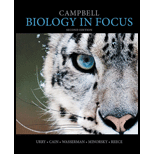
The mammalian trachea and esophagus both connect to the
- A. large intestine.
- B. stomach.
- C. pharynx.
- D. rectum.
Introduction:
The human respiratory system consists of several parts starting from the nose to the lungs. All organs have different functions; for example, nostrils are involved in the inhalation and exhalation of air. The pharynx passes air to the lungs. In this way, all organs have different functions in the body.
Answer to Problem 1TYU
Correct answer:
The structure that is connected to the mammalian trachea and the esophagus is pharynx. Therefore, option (C) is correct.
Explanation of Solution
Reason for the correct statement:
The trachea is also known as the windpipe. It is a cartilaginous structure. The pharynx is located behind the nasal cavity and the mouth, and above the esophagus. It is divided into three sections, namely nasopharynx, oropharynx, and laryngopharynx. It is connected to the trachea and the esophagus.
Option (C) is given as “pharynx”.
“In mammals, both trachea and esophagus are connected to the pharynx. The pharynx is found in both vertebrates and the invertebrates, but its anatomy varies from one organism to another. Thus, it is the right answer.
Hence, option (C) is correct.
Reason for the incorrect statements:
Option (A) is given as “large intestine”.
The large intestine is not connected to the trachea and the esophagus. Therefore, it is a wrong answer.
Option (B) is given as “stomach”.
The function of the stomach is food digestion, and it is not connected to the esophagus and the trachea. Therefore, it is a wrong answer.
Option (D) is given as “rectum”.
It is the last part of the human digestive tract and the function of the rectum is to excrete waste from the body. It is not connected to the esophagus and the trachea. Therefore, it is a wrong answer.
Hence, options (A), (B) and (D) are incorrect.
The pharynx is connected to the trachea and the esophagus. In mammals, it is an important part of the respiratory system.
Want to see more full solutions like this?
Chapter 33 Solutions
Campbell Biology in Focus (2nd Edition)
Additional Science Textbook Solutions
Physics for Scientists and Engineers
HUMAN ANATOMY
Campbell Essential Biology (7th Edition)
Biology: Life on Earth with Physiology (11th Edition)
- KD 200- 116- 66- Vec ATF6 (670) ATF6 (402) ATF6 (373) ATF6 (366) I I 45- 1 2 3 4 5 ATFG (360) (e/c) 9V ATFG (402) g ant- ATF anti-KDEL DAPI barrow_forwardWestern blot results: what information can you get? Presence of proteins of your interest Levels of protein expression Levels of protein activation (must use activation state-specific antibody) Decreased function of the ATM kinase in aging mice. A C57BL/6 female 6 month Con IR 20 month C57BL/6 male 6 month 28 month Con IR Con IR Con IR p-ATM (S1981) ATM P-p53 (ser18) Actinarrow_forwardDoes it show the level of proteins? What about the amount? Levels of protein activation? How can you tell? Does the thickness tell you anything? What about the number of the lines?arrow_forward
- WB: Protein of interest visualized by fluorescent Protein A Protein Barrow_forwardQuestion #4: Assume you are able to use CRISPR to create an allele that will convert a cross-pollinated, sexually reproducing crop plant into an obligate apomict. Your edited obligate apomict plants retains all the CRISPR "machinery" necessary to convert the "sexually reproducing" allele to the "obligate apomict" allele. You plant 100 hectares of your edited obligate apomicts in order to increase seed for sale the following year. Neighboring farms and seed producers are growing many different un-edited sexually reproducing varieties of the crop. If your neighbors plant seed harvested from their crops that was pollinated by your crop, should they expect these seeds to generate apomictic or non-apomictic plants? Type your answer here:arrow_forwardcalculate the questions showing the solution including variables,unit and equations all the questiosn below using the data.show solving and answer a) B1, b) B2, c) hybrid rate constant (1) d) hybrid rate constant (2) e) t1/2,dist t1/2,absorb f) t1/2,elim k) apparent central compartment volume (V1,app) p) total AUC (using short cut method) apparent volume of distribution based on AUC (VAUC,app) apparent clearance (CLapp) absolute bioavailabilty of oral route ( AUCiv =116ml)arrow_forward
- Please help me to draw this by hand. In as much detail as possible, hand draw a schematic diagram of the hypothalamic-pituitary-gonad (HPG) axis in the human female. Be sure to include all the relevant structures and hormones. You must define all abbreviations the first time you use them. Please include (and explain) the feedback loops.arrow_forwardPlease refer belowarrow_forwardAaBbCc X AaBbCc individuals are crossed. What is the probability of their offspring having a genotype AABBCC?arrow_forward
- circle a nucleotide in the imagearrow_forward"One of the symmetry breaking events in mouse gastrulation requires the amplification of Nodal on the side of the embryo opposite to the Anterior Visceral Endoderm (AVE). Describe one way by which Nodal gets amplified in this region." My understanding of this is that there are a few ways nodal is amplified though I'm not sure if this is specifically occurs on the opposite side of the AVE. 1. pronodal cleaved by protease -> active nodal 2. Nodal -> BMP4 -> Wnt-> nodal 3. Nodal-> Nodal, Fox1 binding site 4. BMP4 on outside-> nodal Are all of these occuring opposite to AVE?arrow_forwardIf four babies are born on a given day What is the chance all four will be girls? Use genetics lawsarrow_forward
 Concepts of BiologyBiologyISBN:9781938168116Author:Samantha Fowler, Rebecca Roush, James WisePublisher:OpenStax College
Concepts of BiologyBiologyISBN:9781938168116Author:Samantha Fowler, Rebecca Roush, James WisePublisher:OpenStax College
 Human Physiology: From Cells to Systems (MindTap ...BiologyISBN:9781285866932Author:Lauralee SherwoodPublisher:Cengage LearningEssentials of Pharmacology for Health ProfessionsNursingISBN:9781305441620Author:WOODROWPublisher:Cengage
Human Physiology: From Cells to Systems (MindTap ...BiologyISBN:9781285866932Author:Lauralee SherwoodPublisher:Cengage LearningEssentials of Pharmacology for Health ProfessionsNursingISBN:9781305441620Author:WOODROWPublisher:Cengage





